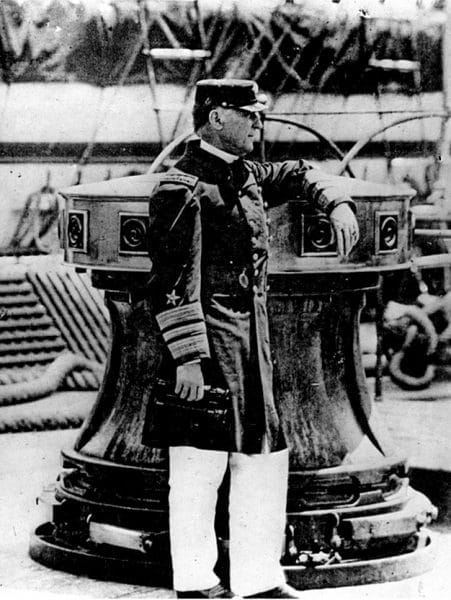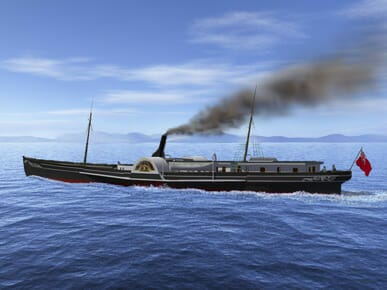Blockade Running in the Civil War
Blockade running, and the use of small swift ships known as blockade runners, was the Confederacy’s response to the Union blockade ordered by President Abraham Lincoln on April 19, 1861, one week after Confederate forces fired on Fort Sumter. The main objective of the blockade was not only to prevent much-needed supplies from entering the southern states, but also to prevent the major southern export, cotton, from leaving the South’s principal ports: New Orleans, Louisiana; Charleston, South Carolina; and Mobile, Alabama.
 Fort Morgan
During the first two years of the war, the blockade had limited effectiveness, with as many as two-thirds of the ships successfully entering and leaving ports in the South. Mobile was in an ideal position to launch and receive blockade runners. The harbor was guarded by two forts, Fort Gaines on Dauphin Island, and Fort Morgan on the Eastern side of the entrance to the bay. However, by the last two years of the conflict, the overall success rate for running the blockade had dropped to less than 25 percent. This was in large part the result of the increased numbers of ships that the Union brought into service and placed on blockade duty. Although the blockade was never completely successful, it did have a negative impact on the already faltering Confederate economy and was a blow to southern morale.
Fort Morgan
During the first two years of the war, the blockade had limited effectiveness, with as many as two-thirds of the ships successfully entering and leaving ports in the South. Mobile was in an ideal position to launch and receive blockade runners. The harbor was guarded by two forts, Fort Gaines on Dauphin Island, and Fort Morgan on the Eastern side of the entrance to the bay. However, by the last two years of the conflict, the overall success rate for running the blockade had dropped to less than 25 percent. This was in large part the result of the increased numbers of ships that the Union brought into service and placed on blockade duty. Although the blockade was never completely successful, it did have a negative impact on the already faltering Confederate economy and was a blow to southern morale.
Before the outbreak of war, two-thirds of the revenue generated by the United States came from the exportation of cotton. Between September 1860 and August 1861, Mobile was the second-most important port in the nation for exportation of cotton, shipping some 456,421 bales valued at more than $25 million, although this was well below the numbers shipped from New Orleans. With the outbreak of war, Confederate president Jefferson Davis decreed that cotton should be left to rot on the wharf to deprive Great Britain and France of the raw materials that fed their textile industries, hoping to force those countries into supporting the Confederacy.
The cotton crop of 1860 had been bountiful, however, and thus there was no shortage of cotton in the North or Great Britain. As a result, millions of dollars’ worth of cotton went to waste and no revenue was produced to purchase valuable items such as weapons, gunpowder, uniforms, or medicine. This tactic only aided the Union Navy in its establishment of the blockade, which was a very difficult task given the fewer than 40 federal ships on active duty, few of which were modern steamers.
 David G. Farragut
The Union established the Gulf Blockading Squadron on October 29, 1861. Based at Key West, Florida, this fleet was responsible for maintaining the Union blockade from that point to the Texas-Mexico border at the Rio Grande River. On February 20, 1862, naval leaders decided to split the responsibility of the blockade in the Gulf among two squadrons, the East Gulf Blockade Squadron, which remained at Key West and was responsible for the Florida Gulf Coast up to Pensacola, and the West Gulf Blockade Squadron under the command of Flag Officer David G. Farragut, which enforced the blockade from Pensacola to the Rio Grande. Union blockaders were, however, spread out and could not effectively shut off the Port of Mobile to fast ships.
David G. Farragut
The Union established the Gulf Blockading Squadron on October 29, 1861. Based at Key West, Florida, this fleet was responsible for maintaining the Union blockade from that point to the Texas-Mexico border at the Rio Grande River. On February 20, 1862, naval leaders decided to split the responsibility of the blockade in the Gulf among two squadrons, the East Gulf Blockade Squadron, which remained at Key West and was responsible for the Florida Gulf Coast up to Pensacola, and the West Gulf Blockade Squadron under the command of Flag Officer David G. Farragut, which enforced the blockade from Pensacola to the Rio Grande. Union blockaders were, however, spread out and could not effectively shut off the Port of Mobile to fast ships.
Initially, few southern owners of cargo vessels wished to give up shipping profitable luxury goods such as clothing, silks, and alcohol. To solve this problem, the Confederate government introduced an approach called the “New Plan” in late 1863. When first implemented, the policy required southern ship owners to set aside one-third of the cargo space on ships, some of which were captained by Confederate naval officers, leaving or entering southern ports for transporting cotton and military supplies. The Confederacy then began selling the cotton overseas and buying supplies with the proceeds, thereby cutting out the middlemen and becoming directly involved in blockade running. The plan supervisor, Colin J. McRae, gained direct control over cargo space on blockade runners and by March 1864 increased the space claimed by the Confederate government to half. Owners who refused to accept a fair rate to transport cotton for sale by the government would have their vessels confiscated. The plan was implemented in Wilmington, North Carolina, and Charleston, but was largely ignored along the Gulf.
The first three moderately successful steam ships to run the blockade out of Mobile were the locally owned Alabama, Cuba, and the Fox, a captured ship renamed the Fanny. Between May 1862 and September 1863, these three ships were responsible for carrying more than 4,000 bales of cotton to Havana, Cuba, for sale to European buyers. Using the figures from one of the Alabama’s journeys to Havana in June 1863 as a base figure, with a cotton bale weighing about 510 pounds and cotton selling at $0.32 cents per pound, a little more than $3 million in cotton was exported out of Mobile in the 16 months before Mobile fell. Still, this figure is a meager one-seventh of Mobile’s pre-war commerce level. The Alabama, Cuba, and Fanny were lost by mid September 1863, however. The Cuba was burned to prevent her capture on May 19, 1863, while heading toward Mobile; the Alabama was captured on September 12, 1863 by the Union blockade; and the Fanny was burned that same day to prevent her capture.
 Blockade Runner Denbigh
Large steamers were not the only ships used in blockade running. Schooners, smaller steamers, and sloops carried more than 15,000 bales of southern cotton past the blockade. Three foreign-owned ships also served as blockade runners. The Matagorda, one of 14 ships owned by Charles Morgan’s Southern S. S. Co, was renamed the Alice and placed under British registry, the Laird and Sons-built English steamer Denbigh, and the Northern-built Donegal. These were larger ships, with the Matagorda being about 220 ft in length and the Denbigh being about 187 ft. They were under English and Northern registry respectively before coming south. These three ships carried more than 9,000 bales of cotton past the blockade and brought back clothes, wine, sugar, and rum, most of it in late 1863 and 1864, prior to the fall of Mobile. The Donegal was captured by the Union blockader Metacomet on June 6, 1864, while attempting a run into Mobile. The Alice was captured on September 10, 1864, running out of Galveston toward Havana, and the Denbigh ran aground on May 23, 1865, while trying to enter the port of Galveston and was burned the next day by the Union blockade. Many of the local ships, especially the riverboats, were captured with relative ease by the Union Navy. The sleek and fast foreign-built blockade-running steamers, though, were another matter. In 1864, there were 22 attempts by steamers to reach Mobile; of these 19 were successful and no steam vessel was captured coming out of the port.
Blockade Runner Denbigh
Large steamers were not the only ships used in blockade running. Schooners, smaller steamers, and sloops carried more than 15,000 bales of southern cotton past the blockade. Three foreign-owned ships also served as blockade runners. The Matagorda, one of 14 ships owned by Charles Morgan’s Southern S. S. Co, was renamed the Alice and placed under British registry, the Laird and Sons-built English steamer Denbigh, and the Northern-built Donegal. These were larger ships, with the Matagorda being about 220 ft in length and the Denbigh being about 187 ft. They were under English and Northern registry respectively before coming south. These three ships carried more than 9,000 bales of cotton past the blockade and brought back clothes, wine, sugar, and rum, most of it in late 1863 and 1864, prior to the fall of Mobile. The Donegal was captured by the Union blockader Metacomet on June 6, 1864, while attempting a run into Mobile. The Alice was captured on September 10, 1864, running out of Galveston toward Havana, and the Denbigh ran aground on May 23, 1865, while trying to enter the port of Galveston and was burned the next day by the Union blockade. Many of the local ships, especially the riverboats, were captured with relative ease by the Union Navy. The sleek and fast foreign-built blockade-running steamers, though, were another matter. In 1864, there were 22 attempts by steamers to reach Mobile; of these 19 were successful and no steam vessel was captured coming out of the port.
The capture of Mobile Bay by Admiral Farragut’s fleet in August of 1864 virtually eliminated blockade running on the Gulf, although some attempts were still made to run into Texas. This was not a severe blow to the Confederacy because Mobile was never as important a port as either Wilmington or Charleston, which were much closer to the British controlled islands of Bermuda and the Bahamas. Although accurate numbers are difficult to find, historians have estimated that between 32,000 to 35,000 bales of cotton were successfully shipped out of Mobile and past the blockade to Havana in the 30 months between February 1862 and August 1864. Even with the increased price for cotton, this still amounted to less then one-third of the commerce conducted in a single year before the outbreak of war.
Additional Resources
Cochran, Hamilton. Blockade Runners of the Confederacy. Indianapolis: Bobbs-Merrill, 1958.
Davis, Charles S. Colin J. McRae: Confederate Financial Agent. College Station, Texas: Institute of Naval Archaeology, 2008.
English, Andrew R. Chasing the Fox: The Chronology of a Blockade Runner. Baltimore: Gateway Press, 2004.
Wise, Stephen R. Lifeline of the Confederacy. Columbia: University of South Carolina Press, 1988.



